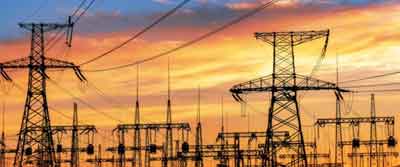America’s Grid Has A Multi-Trillion Dollar Problem
Leonard Hyman and William Tilles
 Numbers are out again permitting us to update our US electric grid’s reliability report card. Last year, 2022, was nowhere near as bad as 2021–the worst year of the 24-year record. It was “only” the fourth worst year. Severe storms, fire, floods, snow, hurricanes — many often in the same places. Whether we call it weather or climate, utilities and other infrastructure providers face new challenges. The electric industry’s response to this increasing cycle of weather disruption followed by system repair is to basically reinforce the status quo with a reassuring, “Don’t worry, we’ll fix the grid better than before.” Implicit in this breezy reassurance is that power will be restored as quickly as possible. But recall that in hurricane alley, Entergy recently informed Louisiana regulators that the next category four hurricanes in their service area would likely disrupt electrical service for a month or more. The utility response to increasingly frequent transmission rebuilds has come to resemble Einstein’s definition of insanity: doing the same thing again and again expecting a different (or improved) outcome. Almost immediately following the recent train derailment and toxic spill in Ohio, members of Congress angrily demanded answers from industry executives and regulators alike. But if critical electric transmission lines routinely fail in every hurricane or blizzard, —often with fatal consequences—that’s apparently something ordained by the gods that we must simply and passively accept. The noteworthy social feature here is the selective absence of community-wide outrage. Lastly, it seems almost obvious to point out that a utility business model relying on the absence of customer outrage over degraded service is ripe for disruption. Numbers are out again permitting us to update our US electric grid’s reliability report card. Last year, 2022, was nowhere near as bad as 2021–the worst year of the 24-year record. It was “only” the fourth worst year. Severe storms, fire, floods, snow, hurricanes — many often in the same places. Whether we call it weather or climate, utilities and other infrastructure providers face new challenges. The electric industry’s response to this increasing cycle of weather disruption followed by system repair is to basically reinforce the status quo with a reassuring, “Don’t worry, we’ll fix the grid better than before.” Implicit in this breezy reassurance is that power will be restored as quickly as possible. But recall that in hurricane alley, Entergy recently informed Louisiana regulators that the next category four hurricanes in their service area would likely disrupt electrical service for a month or more. The utility response to increasingly frequent transmission rebuilds has come to resemble Einstein’s definition of insanity: doing the same thing again and again expecting a different (or improved) outcome. Almost immediately following the recent train derailment and toxic spill in Ohio, members of Congress angrily demanded answers from industry executives and regulators alike. But if critical electric transmission lines routinely fail in every hurricane or blizzard, —often with fatal consequences—that’s apparently something ordained by the gods that we must simply and passively accept. The noteworthy social feature here is the selective absence of community-wide outrage. Lastly, it seems almost obvious to point out that a utility business model relying on the absence of customer outrage over degraded service is ripe for disruption.
However, as modern life in our world becomes more digitized and electrified this presupposes even greater reliability of electricity service. For decades electricity grid experts argued that the grid’s minor perturbations (in other words those flickers and flutters that cut service for a second here and there and force you to readjust clocks or buy power surge protectors) cost the economy tens of billions of dollars a year. But leave that aside. Instead, we looked at the latest data for “major disturbances and unusual events” as tracked by the US Energy Information Administration. The number of disturbances varies dizzyingly from year to year. So, we divided the 24-year data set into four six-year periods. As Figure 1 shows, the major disturbance event count has more than tripled in 24 years and the trend continues to get worse. In this same period, grid capacity and sales rose roughly 15%. In other words, grid failures have increased much faster than the volume of electricity sales.
Related:
Figure 1. Number of major disturbances and unusual events (yearly average)

The US government also collects information about the size of the occurrence — whether the load loss exceeded 100 MW or affected 100,000 or more customers. Electric companies, however, often do not provide that information. Thus, Figure 2 provides incomplete data, which also seem to show that both categories of occurrences (disturbances) have grown faster than sales and capacity and certainly demonstrate no improvement in service reliability.
Figure 2. Occurrences of 100 MW or involving 100,000 or more customers (average per year)

The recently passed Inflation Reduction Act promises billions to improve the grid. We regard that as good news. But we also have calculated that the grid really needs trillions of dollars of new investment — that is more than double current levels of capital spending— to both modernize and decarbonize. If we assume further electrification of transportation, industry, and building systems this will place even greater demands on the grid.
Improving grid reliability requires huge investment in what utility executives may think of as “unproductive plant.” That means these new assets, no matter how reliable, are initially unaccompanied by incremental sales revenues to pay for them. As a result, the utility asks regulators to raise prices in order to maintain its profitability levels. This cycle of making new utility investments first and then recovering them later over long periods is a well established feature of US utility regulation. In the past, we worried that low growth in electricity sales would threaten the financial stability of the utility regulatory model. Now we worry about the opposite problem but with a twist. Growth of the grid almost always means higher prices for utility customers. But now what happens when those higher electricity prices are accompanied by increasingly degraded service levels, weeks long power outages, and so on? Will customers remain passive or will they begin to seek alternatives offering superior reliability?
Imagining ourselves as utility executives, if we really thought our customers would remain passive in the face of increasingly degraded service then we would only invest the bare minimum in reliability related investment. This is somewhat akin to the boiling frog analogy. As a result it is possible that US electric reliability declines further. Electrification only increases demands on an already fragile system. As a result, it is possible that the electricity market moves toward a so-called concierge model. (Think about modern medicine. Patients who want more than 10 minutes time from a harried doctor working for a big medical organization can, instead, pay an annual membership fee that gives them access to independent “concierge” doctors who have a far more thorough and relaxed approach to patient care.) This arrangement promotes medical inequality, of course. And that is our point. Electricity or access to it may come to resemble health care and the inequality that implies.
Now, imagine ourselves as regulators, that is politicians who have to raise prices to improve service. They have the same motives as politicians who won’t raise tolls to really fix a bridge, but instead apply some asphalt and hope the really big cracks don’t show until they have moved on to another office. Faced with big rate hike requirements to pay for investment in new plants, they will, we predict, trim out investments whose excision produces no immediate consequence, or possibly a consequence that can be blamed on the weather. Ditto for utility executives. They will make the investment that customers require immediately, not what the customer might wish for down the road. Although conventional economic theory says that utility managers love to invest because doing so increases rate base, they still face limits because regulators will draw line, that is, cap investments when the number produces too big a rate hike. Reliability investments can be put off, not investment to meet the needs of the big new factory coming to town.
Anyway, those well resourced customers requiring state-of-the-art electricity reliability regardless of costs will achieve it through considerable private investment in on-site generation, storage, and microgrids. At this point staying connected to the grid, and paying monthly utility charges, becomes a matter of choice not necessity. As a practical matter for a residential customer this would mean a combination of solar, batteries, and diesel or propane backup generators for complete grid independence. In the meantime the remaining electricity customers receive a lower quality service, as suggested by our data. The key difference is that now energy customers with adequate financial means can obtain whatever equipment they need, equipment possibly even more modern than the local utility’s. Several decades ago going off grid meant campfires, candles, or flashlights after the sun went down. Now keeping the lights on is a simple matter of incurring a considerable capital expense.
This prognosis has social, business, and investment implications. First, it implies greater or growing energy inequality in the US. Those without, let’s call it, above average resources will get the average grid reliability which we expect will decline. Those with capital for self generation and storage will get something far better and more reliable. Second, if grid reliability continues on its present downward path, declining below what many consider an acceptable level, those requiring higher grid reliability might as well start planning their exit now rather than waiting for the next wildfire or hurricane. Thirdly, for investors, our prognosis should encourage a serious look at technologies that enhance reliability on the customer’s premises or for microgrids. We also expect increased investment in electrical reliability that does not depend on the utility grid and whose capacity to invest will not be restrained by regulators.
Mind you, we don’t suggest that our vision of reliability is the most economical, ecological, or even equitable. It just seems most probable considering our existing institutions and the current array of financial incentives.
By Leonard Hyman and William Tilles for Oilprice.com

Leonard S. Hyman is an economist and financial analyst specializing in the energy sector. He headed utility equity research at a major brokerage house and has provided advice on industry organization, regulation, privatization, risk management and finance to investment bankers, governments and private firms, including one effort to place nuclear fusion reactors on the moon. He is a Chartered Financial Analyst and author, co-author or editor of six books including America’s Electric Utilities: Past, Present and Future and Energy Risk Management: A Primer for the Utility Industry.

William I. Tilles is a senior industry advisor and speaker on energy and finance. After starting his career at a bond rating agency, he turned to equities and headed utility equity research at two major brokerage houses and then became a portfolio manager investing in long/short global utility equities. For a time he ran the largest long/short utilities equity book in the world. Before going into finance, Mr. Tilles taught political science .
oilprice.com
|


